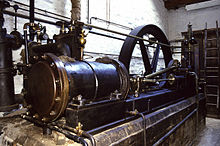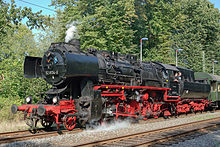
Back Stoomenjin Afrikaans Dampfmaschine ALS Maquina de vapor AN भाप इंजन ANP محرك بخاري Arabic ভাপ ইঞ্জিন Assamese Máquina de vapor AST Buxar maşını Azerbaijani بوخار ماشینی AZB Пар машинаһы Bashkir
| History of technology |
|---|




A steam engine is a heat engine that performs mechanical work using steam as its working fluid. The steam engine uses the force produced by steam pressure to push a piston back and forth inside a cylinder. This pushing force can be transformed by a connecting rod and crank into rotational force for work. The term "steam engine" is most commonly applied to reciprocating engines as just described, although some authorities have also referred to the steam turbine and devices such as Hero's aeolipile as "steam engines". The essential feature of steam engines is that they are external combustion engines,[1] where the working fluid is separated from the combustion products. The ideal thermodynamic cycle used to analyze this process is called the Rankine cycle. In general usage, the term steam engine can refer to either complete steam plants (including boilers etc.), such as railway steam locomotives and portable engines, or may refer to the piston or turbine machinery alone, as in the beam engine and stationary steam engine.
As noted, steam-driven devices such as the aeolipile were known in the first century AD, and there were a few other uses recorded in the 16th century. In 1606 Jerónimo de Ayanz y Beaumont patented his invention of the first steam-powered water pump for draining mines.[2] Thomas Savery is considered the inventor of the first commercially used steam powered device, a steam pump that used steam pressure operating directly on the water. The first commercially successful engine that could transmit continuous power to a machine was developed in 1712 by Thomas Newcomen. James Watt made a critical improvement in 1764, by removing spent steam to a separate vessel for condensation, greatly improving the amount of work obtained per unit of fuel consumed. By the 19th century, stationary steam engines powered the factories of the Industrial Revolution. Steam engines replaced sails for ships on paddle steamers, and steam locomotives operated on the railways.
Reciprocating piston type steam engines were the dominant source of power until the early 20th century. The efficiency of stationary steam engine increased dramatically until about 1922.[3] The highest Rankine Cycle Efficiency of 91% and combined thermal efficiency of 31% was demonstrated and published in 1921 and 1928.[4] Advances in the design of electric motors and internal combustion engines resulted in the gradual replacement of steam engines in commercial usage. Steam turbines replaced reciprocating engines in power generation, due to lower cost, higher operating speed, and higher efficiency.[5] Note that small scale steam turbines are much less efficient than large ones.[6]
As of 2023[update], large reciprocating piston steam engines are still being manufactured in Germany.[7]
Cite error: There are <ref group=lower-alpha> tags or {{efn}} templates on this page, but the references will not show without a {{reflist|group=lower-alpha}} template or {{notelist}} template (see the help page).
- ^ American Heritage Dictionary of the English Language (4th ed.). Houghton Mifflin Company. 2000.
- ^ "Who Invented the Steam Engine?". Live Science. 19 March 2014.
- ^ Mierisch, Robert Charles (May 2018). "The History and Future of High Efficiency Steam Engines" (PDF). EHA Magazine. 2 (8): 24–25 – via engineersaustralia.org.au.
- ^ Gebhardt, G.F. (1928). Steam Power Plant Engineering (6th ed.). USA: John Wiley and Sons, Inc. p. 405.
- ^ Cite error: The named reference
Wiserwas invoked but never defined (see the help page). - ^ Green, Don (1997). Perry's Chemical Engineers' Handbook (7th ed.). USA: McGraw-Hill. pp. 29–24. ISBN 0-07-049841-5.
- ^ "Spilling Products". www.spilling.de. 5 October 2023. Retrieved 5 October 2023.